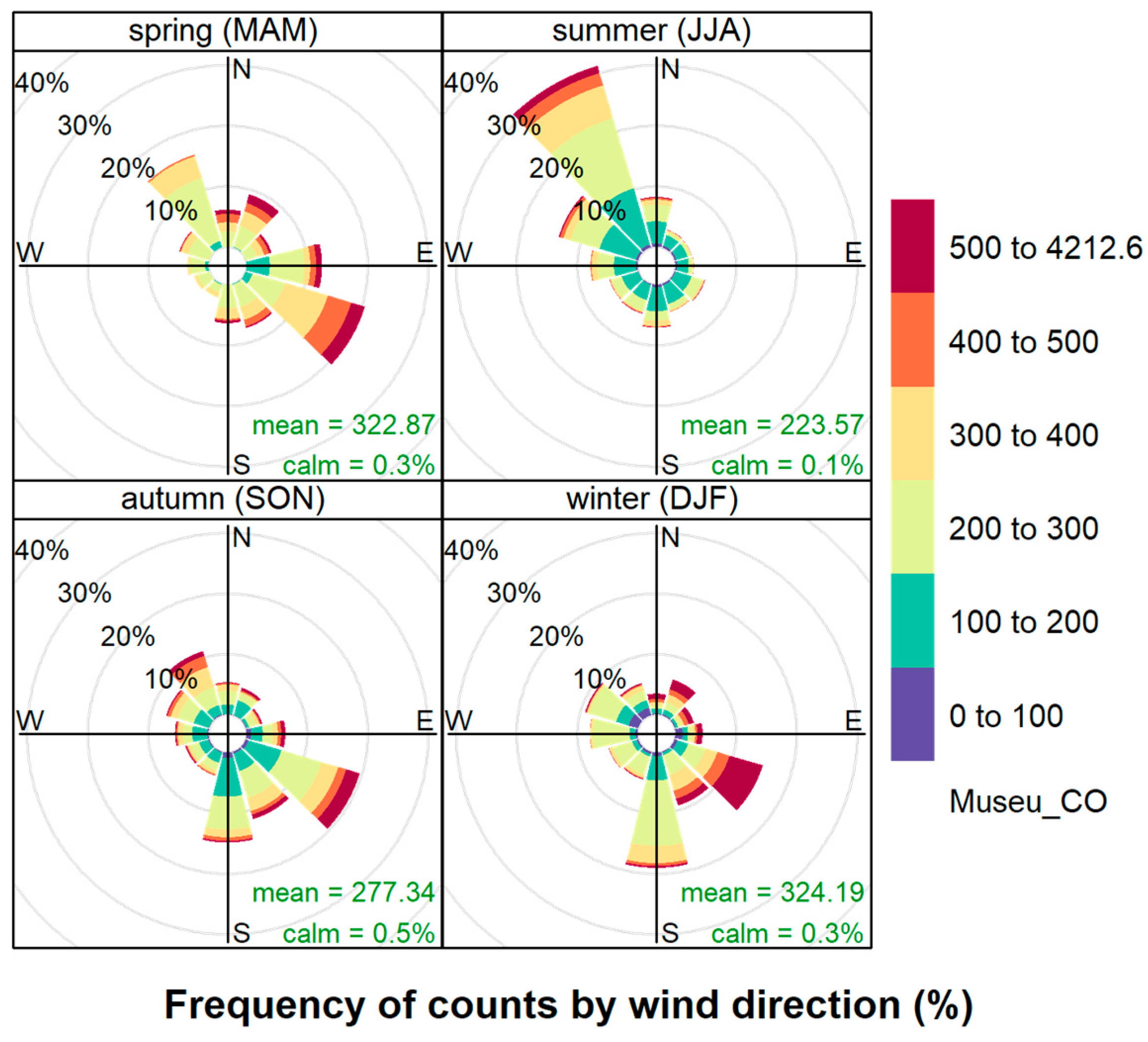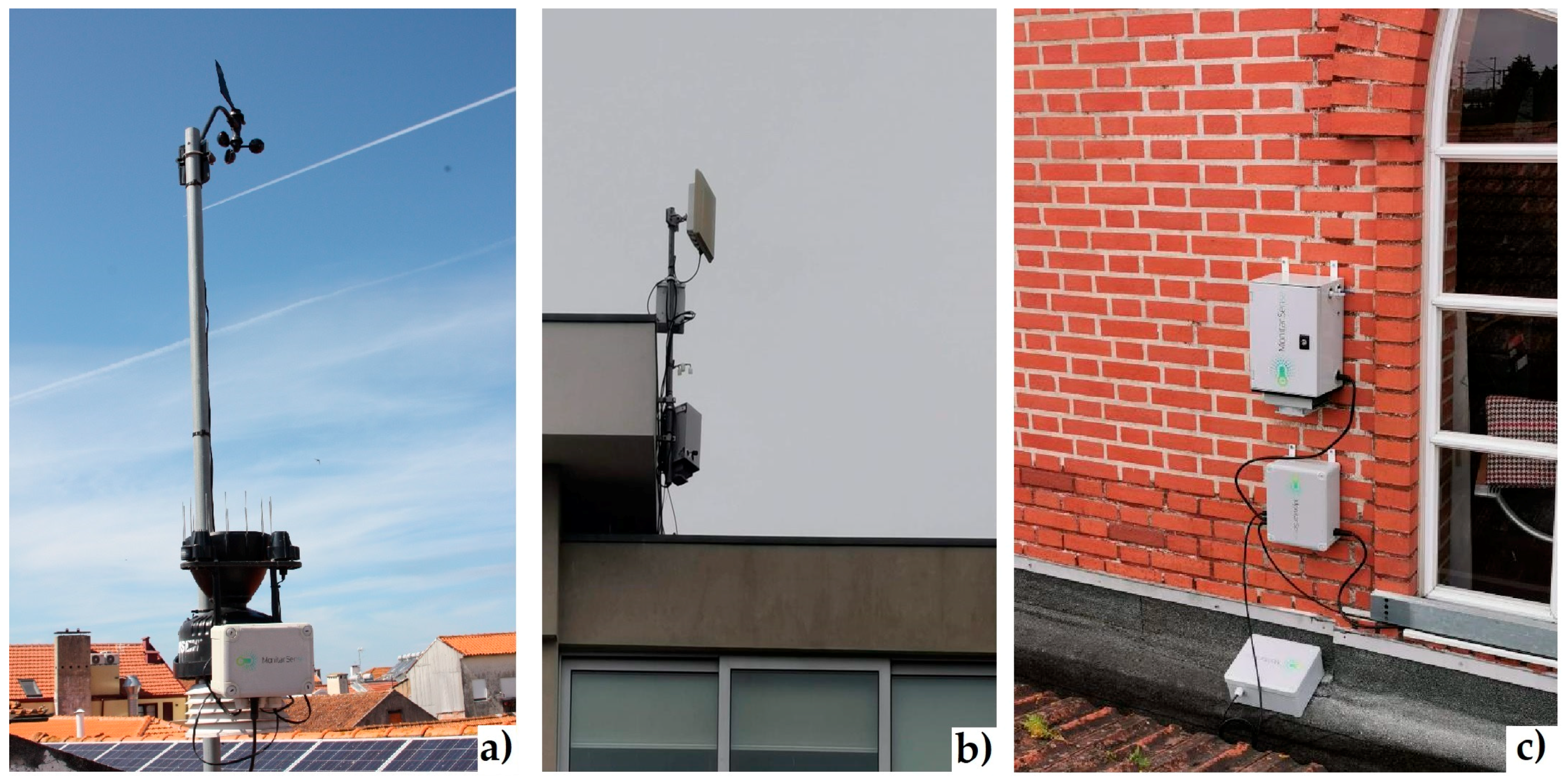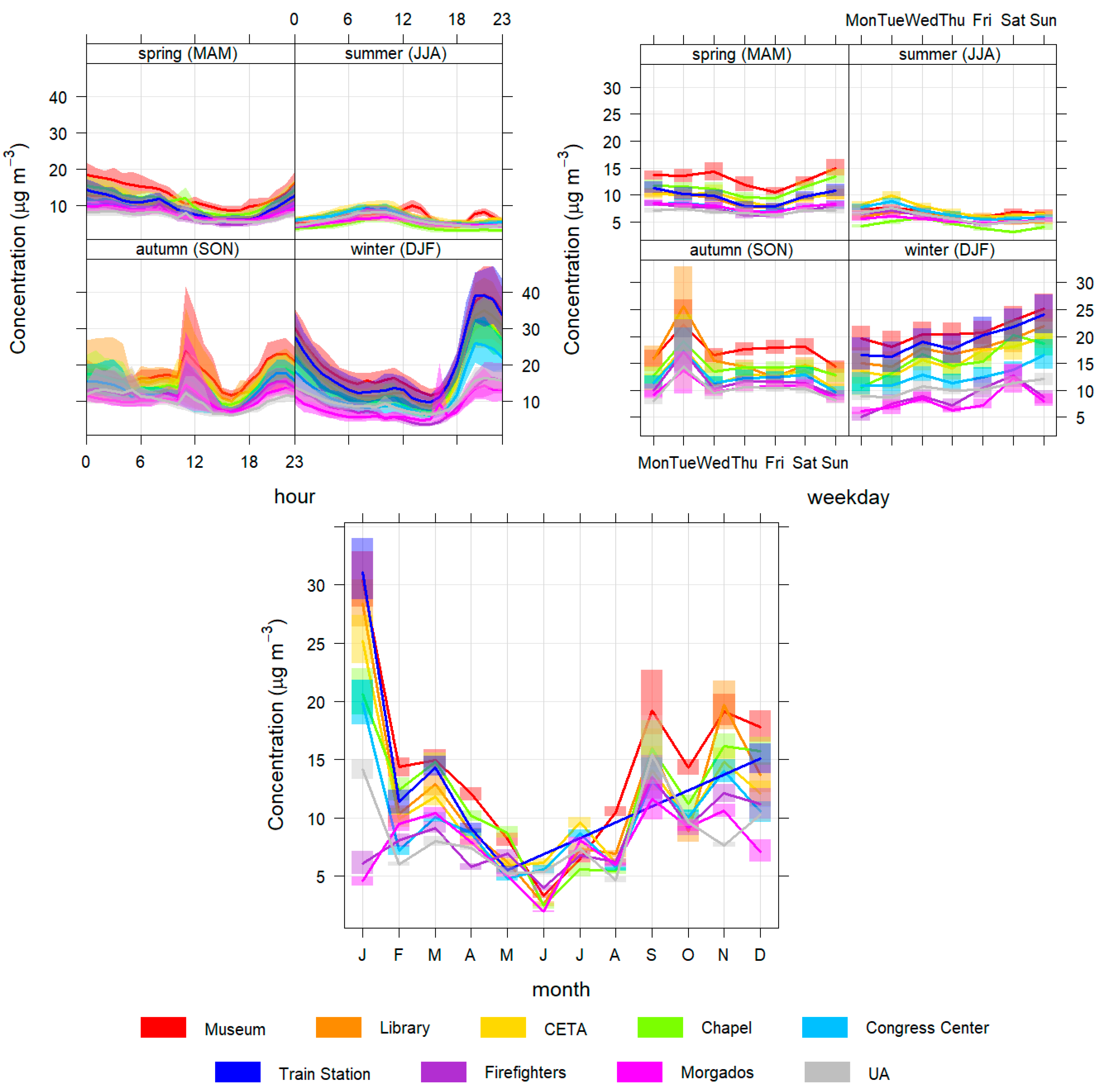Sensors Network as an Added Value for the Characterization of Spatial and Temporal Air Quality Patterns at the Urban Scale
Abstract
1. Introduction
2. Materials and Methods
2.1. Study Site
- Electricity and communication access;
- Adequate security measures;
- Least possible exposure to meteorological elements;
- Avoid proximity to sources of air pollution, such as chimneys and exhaust vents, to avoid sensor saturation and inaccurate measurements of ambient air;
- Installation preferably in buildings owned or managed by the municipality;
- Proximity to main avenues, highways, parking lots and tourist areas.
2.2. Sensors Stations Monitoring Equipment
2.3. Data Collection and Validation Procedure
2.4. Statistic Evaluation Indexes
2.5. Graphical Visualization
3. Results and Discussion
3.1. Validation Procedure
- Problems in the proper functioning of the sensors due to interference from temperature and humidity extremes (condensation inside the station and/or in the sampling sockets);
- Deviations in concentrations measured by sensors and need for adjustments of the baseline;
- Malfunctions of internal components in the monitoring stations (filling of filters, rupture of filter door and problems in the thermal regulation of the station during meteorological extremes);
- Communication failures with data storage systems;
- Power failures resulting from problems in the electricity grid and lightning electrical discharges.
3.2. Comparison between Measurements from the Sensors Stations and the Reference Station
3.3. Air Pollution Extremes
3.4. Temporal Analysis
3.5. Spatial Analysis
4. Conclusions
Supplementary Materials
Author Contributions
Funding
Institutional Review Board Statement
Informed Consent Statement
Data Availability Statement
Acknowledgments
Conflicts of Interest
Appendix A


References
- WHO. WHO Global Air Quality Guidelines. Particulate Matter (PM2.5 and PM10), Ozone, Nitrogen Dioxide, Sulfur Dioxide and Carbon Monoxide; WHO: Geneva, Switzerland, 2021. [Google Scholar]
- Borrego, C.; Ginja, J.; Coutinho, M.; Ribeiro, C.; Karatzas, K.; Sioumis, T.; Katsifarakis, N.; Konstantinidis, K.; De Vito, S.; Esposito, E.; et al. Assessment of Air Quality Microsensors versus Reference Methods: The EuNetAir Joint Exercise—Part II. Atmos. Environ. 2018, 193, 127–142. [Google Scholar] [CrossRef]
- Borrego, C.; Costa, A.M.; Ginja, J.; Amorim, M.; Coutinho, M.; Karatzas, K.; Sioumis, T.; Katsifarakis, N.; Konstantinidis, K.; De Vito, S.; et al. Assessment of Air Quality Microsensors versus Reference Methods: The EuNetAir Joint Exercise. Atmos. Environ. 2016, 147, 246–263. [Google Scholar] [CrossRef]
- Rogulski, M.; Badyda, A.; Gayer, A.; Reis, J. Improving the Quality of Measurements Made by Alphasense NO2 Non-Reference Sensors Using the Mathematical Methods. Sensors 2022, 22, 3619. [Google Scholar] [CrossRef] [PubMed]
- Miranda, A.; Silveira, C.; Ferreira, J.; Monteiro, A.; Lopes, D.; Relvas, H.; Borrego, C.; Roebeling, P. Current Air Quality Plans in Europe Designed to Support Air Quality Management Policies. Atmos. Pollut. Res. 2015, 6, 434–443. [Google Scholar] [CrossRef]
- Schneider, P.; Castell, N.; Vogt, M.; Dauge, F.R.; Lahoz, W.A.; Bartonova, A. Mapping Urban Air Quality in near Real-Time Using Observations from Low-Cost Sensors and Model Information. Environ. Int. 2017, 106, 234–247. [Google Scholar] [CrossRef]
- Kumar, P.; Morawska, L.; Martani, C.; Biskos, G.; Neophytou, M.; Di Sabatino, S.; Bell, M.; Norford, L.; Britter, R. The Rise of Low-Cost Sensing for Managing Air Pollution in Cities. Environ. Int. 2015, 75, 199–205. [Google Scholar] [CrossRef] [PubMed]
- Williams, R.; Kilaru, V.J.; Snyder, E.G.; Kaufman, A.; Dye, T.; Rutter, A.; Russell, A.; Hafner, H. Air Sensor Guidebook; Epa/600/R-14/159; U.S. Environmental Protection Agency: Washington, DC, USA, 2014; pp. 1–5. [Google Scholar]
- WMO. An Update on Low-Cost Sensors for the Measurement of Atmospheric Composition; WMO: Geneva, Switzerland, 2020. [Google Scholar]
- Concas, F.; Mineraud, J.; Lagerspetz, E.; Varjonen, S.; Liu, X.; Puolamäki, K.; Nurmi, P.; Tarkoma, S. Low-Cost Outdoor Air Quality Monitoring and Sensor Calibration: A Survey and Critical Analysis. ACM Trans. Sens. Netw. 2021, 17, 1–44. [Google Scholar] [CrossRef]
- Castell, N.; Dauge, F.R.; Schneider, P.; Vogt, M.; Lerner, U.; Fishbain, B.; Broday, D.; Bartonova, A. Can Commercial Low-Cost Sensor Platforms Contribute to Air Quality Monitoring and Exposure Estimates? Environ. Int. 2017, 99, 293–302. [Google Scholar] [CrossRef]
- Danek, T.; Zaręba, M. The Use of Public Data from Low-Cost Sensors for the Geospatial Analysis of Air Pollution from Solid Fuel Heating during the COVID-19 Pandemic Spring Period in Krakow, Poland. Sensors 2021, 21, 5208. [Google Scholar] [CrossRef]
- Lung, C.; Jones, R.; Zellweger, C.; Karppinen, A.; Penza, M.; Dye, T.; Hüglin, C.; Ning, Z.; Leigh, R.; Hagan, D.H.; et al. Low-Cost Sensors for the Measurement of Atmospheric Composition: Overview of Topic and Future Applications; World Meteorological Organization: Geneva, Switzerland, 2018; ISBN 9789263112156. [Google Scholar]
- European Commission. Proposal for a Directive of the European Parliament and of the Council on Ambient Air Quality and Cleaner Air for Europe; European Commission: Brussels, Belgium, 2022. [Google Scholar]
- European Commission CT6—Low-Cost Sensors. Available online: https://fairmode.jrc.ec.europa.eu/activity/ct6 (accessed on 1 November 2022).
- Mahajan, S.; Kumar, P.; Pinto, J.A.; Riccetti, A.; Schaaf, K.; Camprodon, G.; Smári, V.; Passani, A.; Forino, G. A Citizen Science Approach for Enhancing Public Understanding of Air Pollution. Sustain. Cities Soc. 2020, 52, 101800. [Google Scholar] [CrossRef]
- Rito, P.; Almeida, A.; Figueiredo, A.; Gomes, C.; Teixeira, P.; Rosmaninho, R.; Lopes, R.; Dias, D.; Vítor, G.; Perna, G.; et al. Aveiro Tech City Living Lab: A Communication, Sensing and Computing Platform for City Environments. arXiv 2022, arXiv:2207.12200. [Google Scholar]
- DIRECTIVE 2008/50/EC of the European Parliament and of the Council of 21 May 2008 on Ambient Air Quality and Cleaner Air for Europe. 2008. Available online: http://data.europa.eu/eli/dir/2008/50/oj (accessed on 16 June 2022).
- INE, I.P. Censos de 2021—Resultados Preliminiares. Available online: https://censos.ine.pt/scripts/db_censos_2021.html (accessed on 30 August 2022).
- Pinho, O.S.; Orgaz, M.D.M. The Urban Heat Island in a Small City in Coastal Portugal. Int. J. Biometeorol. 2000, 44, 198–203. [Google Scholar] [CrossRef] [PubMed]
- CMA. Revisão Do PDM de Aveiro, Estudos de Caracterização, Sistema de Risco, Relatório No6; CMA: Aveiro, Portugarl, 2019. [Google Scholar]
- Narra, P.; Coelho, C.; Sancho, F. Multicriteria GIS-Based Estimation of Coastal Erosion Risk: Implementation to Aveiro Sandy Coast, Portugal. Ocean Coast. Manag. 2019, 178, 104845. [Google Scholar] [CrossRef]
- IPMA Instituto Português Do Mar e Da Atmosfera—Normais Climatológicas. Available online: https://www.ipma.pt/pt/oclima/normais.clima/ (accessed on 16 June 2022).
- Rodrigues, V.; Gama, C.; Ascenso, A.; Oliveira, K.; Coelho, S.; Monteiro, A.; Hayes, E.; Lopes, M. Assessing Air Pollution in European Cities to Support a Citizen Centered Approach to Air Quality Management. Sci. Total Environ. 2021, 799, 149311. [Google Scholar] [CrossRef]
- IPMA Instituto Português Do Mar e Da Atmosfera—Normais Climatológicas—1971–2000. Available online: https://www.ipma.pt/pt/oclima/normais.clima/1971-2000/#102 (accessed on 16 June 2022).
- APA, (Agência Portuguesa do Ambiente). Qalar—Informação Sobre Qualidade Do Ar. Available online: https://qualar.apambiente.pt/ (accessed on 25 October 2022).
- APA Portal Do Estado Do Ambiente de Portugal—Ar e Ruído, Índice de Qualidade Do Ar. Available online: https://rea.apambiente.pt/content/índice-de-qualidade-do-ar (accessed on 30 July 2021).
- Gama, C.; Relvas, H.; Lopes, M.; Monteiro, A. The Impact of COVID-19 on Air Quality Levels in Portugal: A Way to Assess Traffic Contribution. Environ. Res. 2021, 193, 110515. [Google Scholar] [CrossRef]
- van Zoest, V.; Osei, F.B.; Stein, A.; Hoek, G. Calibration of Low-Cost NO2 Sensors in an Urban Air Quality Network. Atmos. Environ. 2019, 210, 66–75. [Google Scholar] [CrossRef]
- Miskell, G.; Salmond, J.; Williams, D.E. Low-Cost Sensors and Crowd-Sourced Data: Observations of Siting Impacts on a Network of Air-Quality Instruments. Sci. Total Environ. 2017, 575, 1119–1129. [Google Scholar] [CrossRef]
- Reis, J.; Lopes, D.; Graça, D.; Fernandes, A.P.; Miranda, A.I.; Lopes, M. Using Low-Cost Sensors to Assess Real-Time Comfort and Air Quality Patterns in Indoor Households. Environ. Sci. Pollut. Res. 2022, 30, 7736–7751. [Google Scholar] [CrossRef]
- Arnaudo, E.; Farasin, A.; Rossi, C. A Comparative Analysis for Air Quality Estimation from Traffic and Meteorological Data. Appl. Sci. 2020, 10, 4587. [Google Scholar] [CrossRef]
- APA Método de Cálculo Dos Índices de Qualidade Do Ar. Available online: https://qualar.apambiente.pt/node/metodo-calculo-indices (accessed on 6 April 2022).
- Carslaw, D.C.; Ropkins, K. Openair—An R Package for Air Quality Data Analysis. Environ. Model. Softw. 2012, 27–28, 52–61. [Google Scholar] [CrossRef]
- Carslaw, D. The Openair Manual—Open-Source Tools for Analysing Air Pollution Data. Man. Version 2015, 1, 1–4. [Google Scholar]
- Maharaj, E.A.; D’Urso, P.; Caiado, J. Time Series Clustering and Classification; Chapman and Hall/CRC: Boca Raton, FL, USA, 2019; ISBN 9780429058264. [Google Scholar]
- Borrego, C.; Valente, J.; Carvalho, A.; Sá, E.; Lopes, M.; Miranda, A.I. Contribution of Residential Wood Combustion to PM10 Levels in Portugal. Atmos. Environ. 2010, 44, 642–651. [Google Scholar] [CrossRef]
- Coelho, S.; Ferreira, J.; Rodrigues, V.; Lopes, M. Source Apportionment of Air Pollution in European Urban Areas: Lessons from the ClairCity Project. J. Environ. Manag. 2022, 320, 115899. [Google Scholar] [CrossRef] [PubMed]
- IPMA Boletim Climático de Portugal Continental—Janeiro de 2021. Available online: https://www.ipma.pt/resources.www/docs/im.publicacoes/edicoes.online/20210210/MwKzpGLDLlbYFvCHNjar/cli_20210101_20210331_pcl_mm_co_pt.pdf (accessed on 16 June 2022).
- Evtyugina, M.G.; Nunes, T.; Pio, C.; Costa, C.S. Photochemical Pollution under Sea Breeze Conditions, during Summer, at the Portuguese West Coast. Atmos. Environ. 2006, 40, 6277–6293. [Google Scholar] [CrossRef]
- Gama, C.; Monteiro, A.; Pio, C.; Miranda, A.I.; Baldasano, J.M.; Tchepel, O. Temporal Patterns and Trends of Particulate Matter over Portugal: A Long-Term Analysis of Background Concentrations. Air Qual. Atmos. Health 2018, 11, 397–407. [Google Scholar] [CrossRef]










| Pollutant | Technology | Model | Range (µg/m³) | Accuracy | Time Resolution (Minutes) |
|---|---|---|---|---|---|
| PM10 | Light scattering | Gassensor | 0–500 | 25% at 50 µg/m³ | 5 |
| PM2.5 | Light scattering | Gassensor | 0–500 | ±25 µg/m³ | 5 |
| O3 | Electrochemical Sensor | Alphasense-AH | 5–500 | ±25 µg/m³ | 15 |
| NO2 | Electrochemical Sensor | Alphasense-B42F | 5–500 | ±15 µg/m³ | 15 |
| CO | Electrochemical Sensor | Alphasense CO-AF | 100–15,000 | ±55 µg/m³ | 15 |
| Stations | Environment | Influence | Efficiency (%) | ||||
|---|---|---|---|---|---|---|---|
| PM10 | PM2.5 | NO2 | O3 | CO | |||
| 1—CETA | - | - | 92% | 92% | 93% | 73% | 95% |
| 2—Chapel | - | - | 92% | 92% | 55% | 53% | 91% |
| 3—Train Station | - | - | 99% | 99% | 99% | 95% | 99% |
| 4—Museum | - | - | 93% | 93% | 95% | 94% | 98% |
| 5—Library | - | - | 88% | 88% | 81% | 78% | 84% |
| 6—Morgados | - | - | 76% | 76% | 69% | 76% | 69% |
| 7—Congress Centre | - | - | 99% | 99% | 91% | 93% | 99% |
| 8—University of Aveiro (UA) | - | - | 86% | 86% | 67% | 86% | 84% |
| 9—Firefighters Headquarters | - | - | 76% | 76% | 76% | 74% | 81% |
| Ref. Aveiro | Urban | Traffic | 97% | 100% | 100% | ||
| Ref. Ílhavo | Suburban | Background | 50% | ||||
| Ref. Estarreja | Suburban | Background | 98% | 97% | |||
| NO2 | |||||||||
| Library | Firefighters | Chapel | Congress Centre | CETA | Train Station | Morgados | Museum | University | |
| RMSE | 13.51 | 30.35 | 10.53 | 11.79 | 16.06 | 15.62 | 12.96 | 17.89 | 21.37 |
| NMB | 0.33 | 1.336 | 0.197 | 0.151 | 0.644 | 0.625 | 0.157 | 0.676 | 0.54 |
| r (Pearson) | 0.43 | 0.4 | 0.56 | 0.5 | 0.67 | 0.57 | 0.42 | 0.41 | 0.11 |
| PM10 | |||||||||
| Library | Firefighters | Chapel | Congress Centre | CETA | Train Station | Morgados | Museum | University | |
| RMSE | 18.09 | 15.16 | 16.46 | 16.7 | 15.21 | 21.07 | 12.59 | 17.74 | 15.17 |
| NMB | −0.117 | −0.32 | −0.056 | −0.166 | −0.039 | −0.034 | −0.203 | 0.05 | −0.36 |
| r (Pearson) | 0.6 | 0.61 | 0.57 | 0.6 | 0.68 | 0.56 | 0.73 | 0.66 | 0.62 |
| CO | |||||||||
| Library | Firefighters | Chapel | Congress Centre | CETA | Train Station | Morgados | Museum | University | |
| RMSE | 119.2 | 292.72 | 397.16 | 119.03 | 100.44 | 117.91 | 105.62 | 130.88 | 139.34 |
| NMB | −0.01 | −0.86 | 0.081 | −0.105 | −0.031 | −0.041 | 0.149 | 0.046 | 0.026 |
| r (Pearson) | 0.88 | 0.27 | 0.31 | 0.87 | 0.91 | 0.85 | 0.9 | 0.8 | 0.82 |
Disclaimer/Publisher’s Note: The statements, opinions and data contained in all publications are solely those of the individual author(s) and contributor(s) and not of MDPI and/or the editor(s). MDPI and/or the editor(s) disclaim responsibility for any injury to people or property resulting from any ideas, methods, instructions or products referred to in the content. |
© 2023 by the authors. Licensee MDPI, Basel, Switzerland. This article is an open access article distributed under the terms and conditions of the Creative Commons Attribution (CC BY) license (https://creativecommons.org/licenses/by/4.0/).
Share and Cite
Graça, D.; Reis, J.; Gama, C.; Monteiro, A.; Rodrigues, V.; Rebelo, M.; Borrego, C.; Lopes, M.; Miranda, A.I. Sensors Network as an Added Value for the Characterization of Spatial and Temporal Air Quality Patterns at the Urban Scale. Sensors 2023, 23, 1859. https://doi.org/10.3390/s23041859
Graça D, Reis J, Gama C, Monteiro A, Rodrigues V, Rebelo M, Borrego C, Lopes M, Miranda AI. Sensors Network as an Added Value for the Characterization of Spatial and Temporal Air Quality Patterns at the Urban Scale. Sensors. 2023; 23(4):1859. https://doi.org/10.3390/s23041859
Chicago/Turabian StyleGraça, Daniel, Johnny Reis, Carla Gama, Alexandra Monteiro, Vera Rodrigues, Micael Rebelo, Carlos Borrego, Myriam Lopes, and Ana Isabel Miranda. 2023. "Sensors Network as an Added Value for the Characterization of Spatial and Temporal Air Quality Patterns at the Urban Scale" Sensors 23, no. 4: 1859. https://doi.org/10.3390/s23041859
APA StyleGraça, D., Reis, J., Gama, C., Monteiro, A., Rodrigues, V., Rebelo, M., Borrego, C., Lopes, M., & Miranda, A. I. (2023). Sensors Network as an Added Value for the Characterization of Spatial and Temporal Air Quality Patterns at the Urban Scale. Sensors, 23(4), 1859. https://doi.org/10.3390/s23041859











